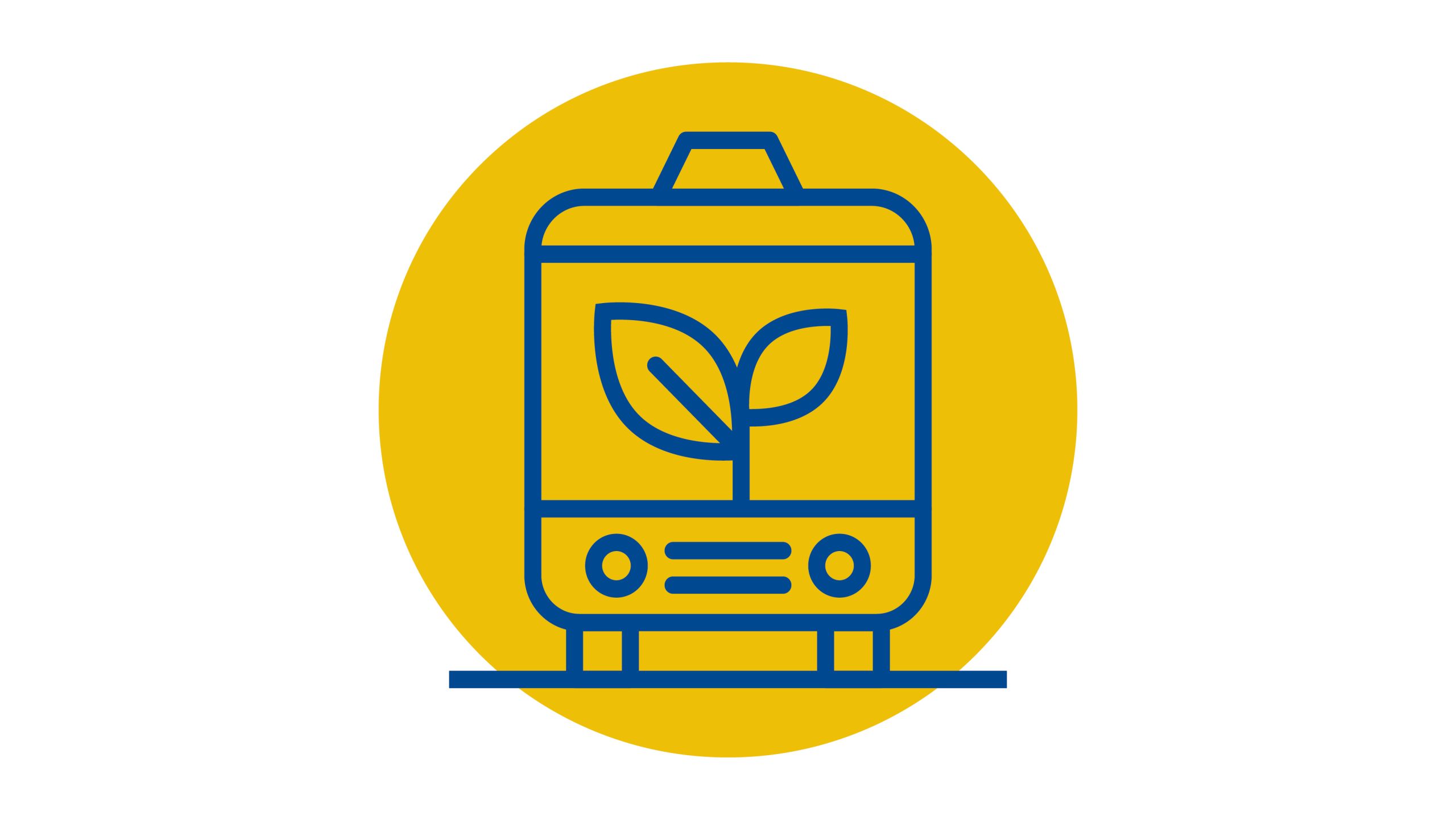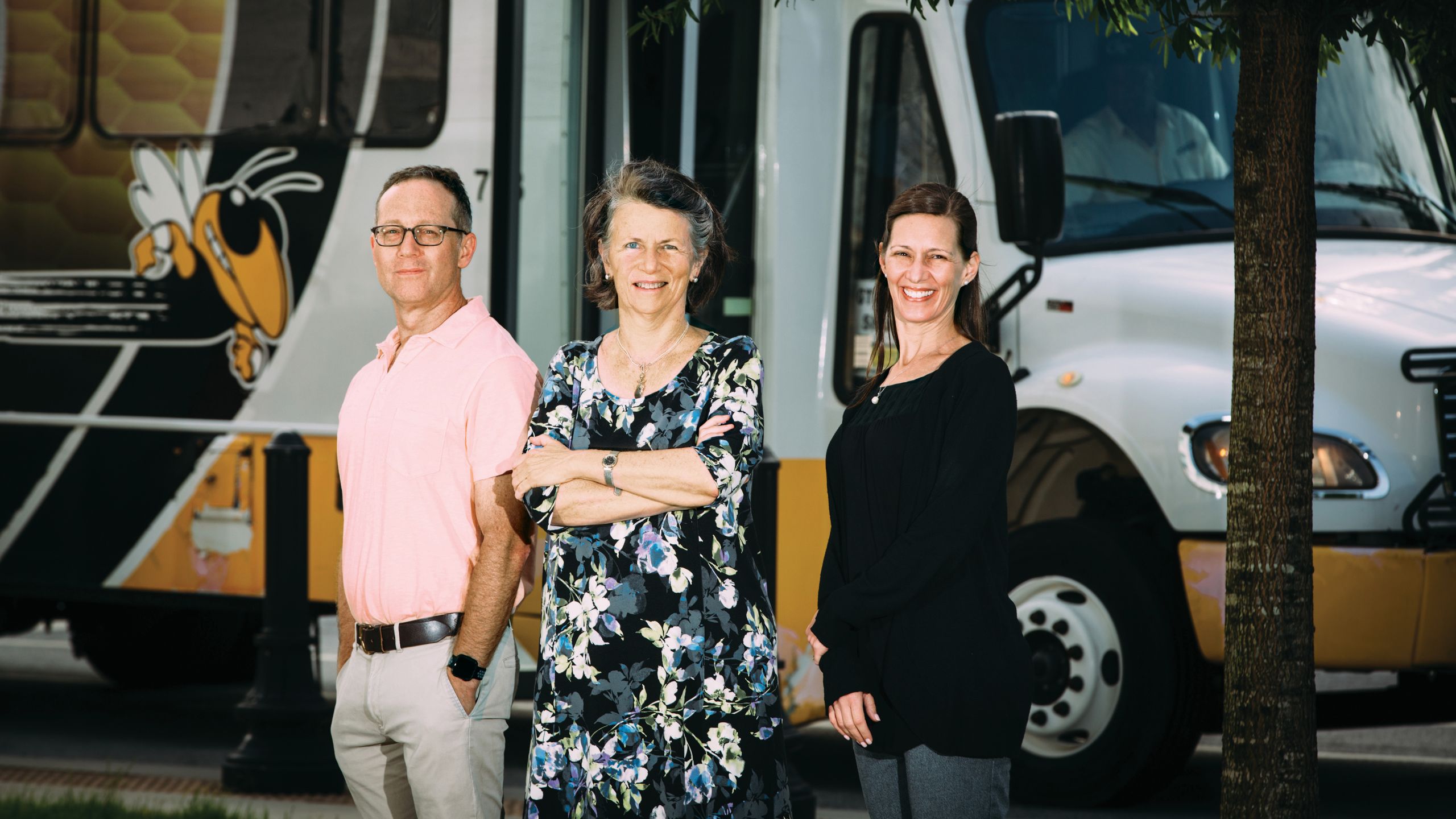Driving innovation
The partnership between Rollins and Georgia Tech fuels rich discovery

Every 80 minutes, Monday through Friday, a bright yellow and white van shuttles between Emory’s Clifton Road campus and Georgia Institute of Technology. Passengers might include graduate students who conduct research in labs on both campuses, dual-degree students splitting classes between locations, and faculty researchers traveling to meetings with co-investigators. The twisting six-mile route that runs along highways and through neighborhoods traces the strong and binding ties between Emory and Georgia Tech.
Those ties include a joint department of biomedical engineering, created by the Emory School of Medicine and the Georgia Tech College of Engineering, which ranks No. 3 in the nation. It includes a research alliance that combines forces to investigate infectious diseases, vaccines, nanotechnology, cancer, cardiology, and pediatrics. And it includes a joint library services center on Emory’s Briarcliff campus that houses a shared collection of materials.
Emory's Rollins School of Public Health has forged its own strong and mutually beneficial partnerships with Georgia Tech. From measuring the impact of air pollution policies on cardiovascular and respiratory health to evaluating measures to increase diabetes screening, the collaborations between Rollins and Georgia Tech researchers have produced work that neither could have accomplished alone.
“Georgia Tech is full of engineers who are really good at solving problems, but they don’t really know what problems need to be solved,” says Dr. Joe Brown, an environmental engineering professor at Georgia Tech with an adjunct appointment in the Rollins Department of Environmental Health. “Rollins is full of researchers who are experts on what and where the problems are. That’s what makes the partnership so powerful. “
Here is a look at some of the magic this partnership has produced.

Clearing the air


A lot of what is known about the air quality in Atlanta and how it impacts health is thanks to the teamwork of Rollins’ environmental health researchers and Georgia Tech engineers and atmospheric scientists. In existence for two decades, the partnership has been able to link air quality with ER visits related to asthma and cardiovascular disease, observe biological changes in Atlanta commuters due to traffic pollution, and assess the impact of air pollution on preterm birth and other reproductive outcomes.
“Most of the work we do is highly multidisciplinary,” says Dr. Jeremy Sarnat, associate professor of environmental health. “Working with experts in engineering, atmospheric chemistry, and particle physics has opened up completely new avenues of research.”
These collaborations culminated in establishment of the Southeastern Center for Air Pollution and Epidemiology, an Environmental Protection Agency (EPA)-funded joint research initiative between Rollins and Georgia Tech’s schools of Civil and Environmental Engineering and Earth and Atmospheric Sciences. The EPA funded four such centers in 2011. “We received the top score nationally, and we were told one of the key reasons was our pairing of a school of public health with an engineering school,” says Dr. Paige Tolbert, O. Wayne Rollins Chair of Environmental Health.

Jeremy Sarnat, Paige Tolbert, and Stefanie Sarnat (l-r) collaborate with colleagues at Georgia Institute of Technology researching the impact of air pollution on health.
Jeremy Sarnat, Paige Tolbert, and Stefanie Sarnat (l-r) collaborate with colleagues at Georgia Institute of Technology researching the impact of air pollution on health.
Basically, researchers at Georgia Tech are able to parse out what chemicals people are exposed to and how much, when, and where those chemicals come from. Then Rollins researchers can measure the health impact of those exposure levels. For example, the EPA might have two or three monitoring stations in Atlanta for a given pollutant. However, people live all over the city. Using advanced modeling techniques and novel targeted measurements, Georgia Tech researchers are able to figure out how much exposure a person has who lives five or ten miles from a monitoring station. Those data allowed a team including Dr. Stefanie Sarnat, associate professor of environmental health, to conclude that clean air measures implemented in Atlanta prevented tens of thousands of asthma- and cardiovascular-related emergency room visits over 15 years. Sarnat is expanding this study to multiple cities to get more generalizable results.
Jeremy Sarnat worked with Georgia Tech counterparts to assess the health impact of traffic pollution on Atlanta commuters and on people living next to the downtown connector, specifically in two Georgia Tech dorms. The former was a daunting project, since measuring the air quality within a moving car is complex. Georgia Tech researchers were able to design and combine sampling instruments and techniques to capture the data that Sarnat needed, which in turn allowed him to identify inflammation and oxidative stress following fairly typical exposure to traffic pollution.
These studies help quantify the health cost of air pollution and conversely, the savings associated with clean air regulations. “By working together, we were able to measure specific health outcomes of regulations developed by the EPA and the state of Georgia,” says Dr. Ted Russell, professor of civil and environmental engineering at Georgia Tech and a collaborator on these projects. “And we’re able to see that some regulations, such as reducing diesel trucking emissions and requiring cleaner power plants, have real health benefits. This work helps close the loop for regulators.”
Exploring exposures


Over a lifetime, people are exposed to untold numbers of pollutants, toxins, and chemicals. That cumulative exposure, along with the body’s response, is called the exposome, and it is often described as the environmental equivalent of the human genome. To study this relatively new and extremely complex concept, the National Institutes of Health funded the country’s first Environmental Health Core Research Center focused on the exposome, Emory’s HERCULES Center. Housed in Rollins, the center is a collaborative effort between researchers at Rollins, Emory at large, and Georgia Tech.
Georgia Tech experts in systems biology, metabolomics, and big data analysis help Rollins researchers gather and make sense of the vast amounts of information involved in the exposome. For example, Drs. Mike Caudle and Qiang Zhang, associate professors of environmental health, are working with Georgia Tech counterparts on single-cell RNA sequencing—looking at how exposures change gene expression in different types of brain cells differently. “It’s the big new thing in environmental health, and we are out in front on it,” says Dr. Carmen Marsit, professor of environmental health and director of HERCULES.
In a study funded by a HERCULES pilot grant, Dr. Melissa Smarr, assistant professor of environmental health, is teaming with a researcher at Georgia Tech who developed the microneedle patch —a bandage-sized patch of painless and dissolvable needles that can be used to administer vaccines. Smarr, however, is not interested in injecting anything into the skin—she wants to draw fluid out.

Carmen Marsit, Mike Caudle, Melissa Smarr, and Qiang Zhang (l-r) work with Georgia Tech researchers to unravel the mysteries of the exposome.
Carmen Marsit, Mike Caudle, Melissa Smarr, and Qiang Zhang (l-r) work with Georgia Tech researchers to unravel the mysteries of the exposome.
Smarr is investigating the health impacts of exposures to phthalates, which are synthetic compounds added to a lot of cosmetics, lotions, and time-release medications. Animal studies have shown phthalates can damage the liver, kidneys, lungs, and reproductive system, but they haven’t been studied extensively in humans. One reason—they are flushed out of the system within hours or days, so they can be hard to detect in a single blood or urine test. Several such tests would provide more information but would be costly and burdensome for participants.
Dr. Mark Prausnitz, the Georgia Tech creator of the microneedle patch, has adapted it so it can extract interstitial fluid—fluid found in the spaces around cells—with the help of a suction device. Theoretically, these small, simple patches could be used over a period of time to chart exposure.
“My goal is to identify novel biomarkers to improve our understanding of human exposures, particularly in populations where it’s hard to get biospecimens, like pregnant women or children,” says Smarr. “Think about how difficult it is to get blood from a child. Microneedles could be a huge advantage for children exposure research.”
Drawing a climate roadmap


The Georgia Climate Project, co-founded by Rollins instructor Daniel Rochberg, brings together climate researchers from Emory, Georgia Tech, the University of Georgia, and several other schools in Georgia. The project is working to build a statewide consortium that can help Georgia better understand how climate change will impact the state and how best to respond to it.
In November, this group will convene the second-ever statewide Georgia Climate Conference. “Climate change is one of this century’s greatest challenges,” says Rochberg. “And we need as many hands on deck as possible. ”
In addition to the conference, the project is undertaking a series of initiatives aimed at boosting the state’s capacity to understand and address climate change. Last year they created a Georgia Climate Research Roadmap, which identifies 40 key climate research questions for the state. Rochberg and his colleagues are in the process of creating an information portal to summarize the answers they have gotten to some of these questions.

Daniel Rochberg collaborates with climate scientists from Georgia Tech and University of Georgia in the Georgia Climate Project.
Daniel Rochberg collaborates with climate scientists from Georgia Tech and University of Georgia in the Georgia Climate Project.
Georgia Tech is taking the lead on a second joint project by the same funder, the Ray C. Anderson Foundation. Called Georgia Drawdown, this project is modeled after Project Drawdown, which identifies 100 things that need to be done to reduce emissions to zero by 2050. “They looked beyond the usual portfolio of solutions,” says Rochberg. “Educating women and girls emerges in the top 10. Reducing food waste shows up in the top 10. There are a lot of nonintuitive findings that are exciting at the global level. We want to identify the Georgia version of this.”
Rochberg has gotten students involved, working with Georgia Tech researchers to build a Georgia Climate Solutions Navigator. Although it is still in the development phase, the navigator is designed as something of a Pinterest for climate solutions. The goal is that both climate experts and concerned citizens will be able to use the navigator to explore concrete things they can do to address climate change.
Emory students also compete in a Carbon Reduction Challenge organized by Georgia Tech, in which students from both schools devise innovative ways to reduce an organization’s carbon emissions. “One of the best examples involved SunTrust,” said Rochberg. “Interns figured out that if the bank changed its car rental policy from midsize to compact cars, it would save the bank $40,000 a year and reduce its carbon footprint. Companies may not have the time to search the nooks and crannies for opportunities to reduce carbon emissions, but this challenge provides a motivated group of students looking for solutions.”
Unbuckling the diabetes belt


The 10 states with the highest type 2 diabetes rates are in the South, forming a “diabetes belt” that stretches across the southeastern United States and up through Appalachia. More than 11 percent of people in those areas have diabetes, compared with 8.5 percent of people outside the diabetes belt, according to the CDC.
The Georgia Center for Diabetes Translation Research—a partnership led by Rollins that includes Georgia Tech, Emory’s schools of medicine, nursing, and business, and Morehouse School of Medicine—is working to improve those grim statistics. The Georgia Tech researchers bring expertise in complex systems modeling that lets researchers plug in a host of “what if” scenarios to predict likely outcomes.
Dr. Shivani Patel, assistant professor of global health, is collaborating with Dr. Douglas Bodner at Georgia Tech to take advantage of this computational power to try to figure out how to get people, especially those who have low economic resources, to be screened for diabetes. Would extending clinic hours make a difference in screening levels? How about increasing the number of community health workers? Offering a financial incentive?

Mohammed K. Ali, Shivani Patel, and K.M. Venkat Narayan (l-r) and Georgia Tech colleagues are trying to discover ways to get more people tested for diabetes and optimize care for those already diagnosed.
Mohammed K. Ali, Shivani Patel, and K.M. Venkat Narayan (l-r) and Georgia Tech colleagues are trying to discover ways to get more people tested for diabetes and optimize care for those already diagnosed.
The team is starting with a small Atlanta study but hopes to expand to put together some actionable data. “We know the problem and the stakeholders, and Georgia Tech knows how to model this and provide quantitative answers,” says Dr. K.M. Venkat Narayan, the Ruth and O.C. Hubert Professor of Global Health and director of the Emory Global Diabetes Research Center. “The ultimate goal is to be able to sit down with the commissioner of public health and show where we can get the most bang for our buck to improve diabetes care.”
Narayan is using Georgia Tech’s prowess in processing big data to make sense of the sea of information that his colleagues at Grady hospital have collected through continuous glucose monitoring. “We typically diagnose diabetes based on one or two glucose tests,” says Narayan. “Now we have these sensors that measure glucose continuously for one to two weeks, and you can only imagine the volume of data that is captured. The Georgia Tech scientists have the methods and the expertise to analyze it, which has allowed us to see that every person with diabetes may be different based on their glucose patterns.”
Dr. Mohammed K. Ali, associate professor of global health, is working with Georgia Tech colleagues to dig deeper into results from randomized controlled trials. “We determine the mean for the intervention and control groups and compare them; if there is a difference, we assert whether that intervention worked or not,” says Ali. “Our colleagues at Georgia Tech have the ability to look between and around those means.”
In other words, many people in the intervention did less well or better than the mean that was attributed to the whole group. Georgia Tech researchers can use machine learning to run multiple simulations from the same data set that can pull out more precise profiles of which participants are doing better or worse.
“So it’s not just looking at men versus women or young versus old,” says Ali. “It’s getting down to a much more discrete profile, such as African American men in their teens and twenties tended to do better because of this reason. It’s getting closer to precision public health.”
Working together in WASH


Researchers at Rollins’ Center for Global Safe WASH have long worked with counterparts at Georgia Tech and are currently collaborating on several projects. Two of these involve the gut microbiome—one in Mozambique to assess the impact of improvements in urban water supply in low-income urban areas on child health, and another in Ecuador looking at differences in infants’ gut microbiome along an urban-rural gradient and how that impacts health.
In Mozambique, Drs. Joe Brown and Kostas Konstantinidis are Georgia Tech colleagues who bring critical engineering expertise. “We wanted to compare the health of people who get the new water system to that of people who don’t,” says Dr. Karen Levy, who co-leads the project with Dr. Matthew Freeman, both associate professors of environmental health. “As an environmental engineer, Joe highlighted many important questions, like how far is the person from the chlorine pumping station? Is the water continuously pressurized? How is the water delivered?”
In Ecuador, Levy builds off the knowledge that people from Western cultures have a much less diverse gut microbiome than those in under-resourced countries. She wanted to see if infants in the same country, with the same diet, culture, and genetic background, had differences in their gut microbiome based on where they were on a gradient of urbanization—rural, intermediate, or urban. Early data suggests those differences exist, with rural infants having the most diversity. Now she is investigating how those differences impact health, particularly from enteric infections. Konstantinidis’ lab is supplying sophisticated sequencing and bioinformatic analysis of the stool samples.

Karen Levy and Matthew Freeman work closely with Georgia Tech researchers to understand the impact of the gut microbiome on child health and the success of some low-resource countries in achieving high vaccination rates.
Karen Levy and Matthew Freeman work closely with Georgia Tech researchers to understand the impact of the gut microbiome on child health and the success of some low-resource countries in achieving high vaccination rates.
“The Georgia Tech researchers are fundamental collaborators,” says Levy. “We’re not saying, ‘Can you run these samples for us?’ This isn’t off-the-shelf analysis. We have weekly meetings where we look at the results we have so far and brainstorm about what to do next.”
Freeman is also working with colleagues from operations research, management, industrial engineering, and public policy at Georgia Tech to determine how a few low-resource countries have been able to achieve high and sustained vaccination rates. This multidisciplinary team, which also includes Emory researchers from Rollins, business, and political science, has “led to an excited intellectual space where researchers bring diverse areas of expertise, methods, and perspectives that spark creativity, leading to new approaches to tackle the thorny challenges of health service delivery in low-income settings,” says Freeman.
These are but some of the fruitful collaborations between the two schools. And even more creative solutions are likely brewing among the passengers on the Emory/Georgia Tech shuttle.
Story by Martha McKenzie
Photography by Stephen Nowland
Designed by Linda Dobson
Want to know more? Please visit
Rollins Emory Public Health Magazine
Emory News Center
Emory University


